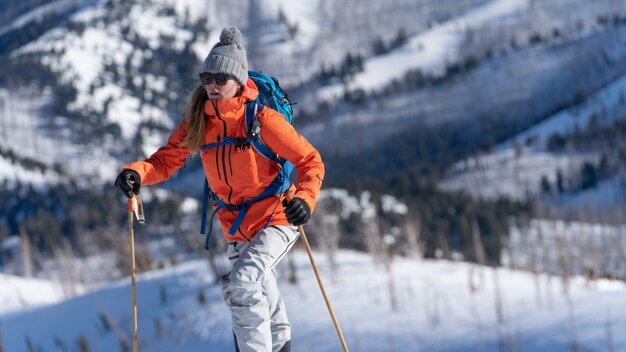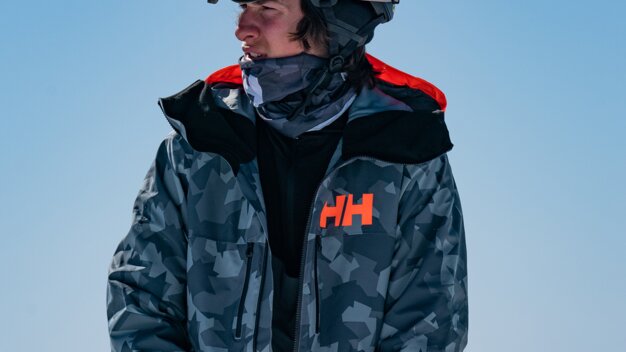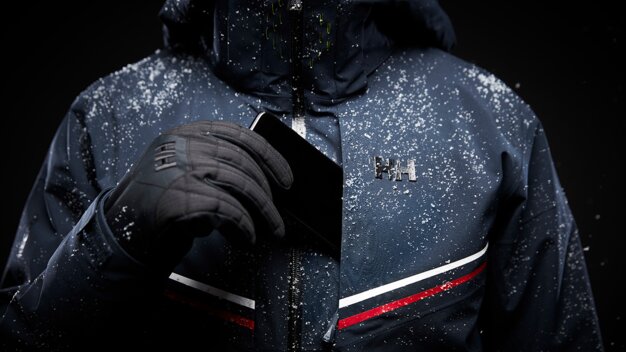
You can’t wait to hit the slopes this season? Then you should take a minute to read this article. Together with the experts of Helly Hansen, we have compiled a 1x1 of ski clothing. Because, as we all know: Staying warm and dry is essential for any winter sport, whether it’s skiing, snowboarding or ski touring.
After all, wet chairlifts and long lift lines can quickly leave you cold and clammy if you wear the wrong clothes. And once the cold has really gotten to you, your fabulous day of skiing or snowboarding is probably about to get cut short.
To make the most of your day in the snow, INTERSPORT Rent and Helly Hansen have compiled 5 tips on how to stay warm & dry in the mountains.
Tip #1: Layer up!
The breathability of your clothes is the key to comfort. After all, an exhausting climb might leave you hot and sweaty, while swooshing down the slopes will quickly make you feel the cold.
Hence, your clothes need to be able to handle perspiration, so you won’t get cold when you stop and take a rest.
Base layer, mid-layer and outer layer
That’s why dressing in layers is the secret weapon of every winter sports athlete. Layering makes sure that moisture gets wicked away from the body, but also that air is trapped between layers and heats up to keep you warm. A good layer outfit usually consists of three layers:
- Base layer: This layer wicks away sweat and keeps the body heat close to your skin. Merino wool and polyester are the two most common base-layer materials. Your base layer should be close-fitting to maximise the fabric’s moisture-wicking capabilities.
- Mid-layer: This layer insulates and traps warm air. It must be highly breathable to allow moisture to escape from your base layer. You have three insulating options to choose from: down, synthetic and fleece.
- Outer layer: Your outer layer should be a fully waterproof shell or insulated jacket to protect you from snow and wind. It should be breathable without letting the cold or moisture in. Ideally, your jacket and pants feature zippered venting to dump any excess body heat.
By the way: You think that adding more and more layers will make you warmer? Not necessarily! In the short term, that might be true but in the long run it can actually make you feel colder.
After all, if sweat and moisture are trapped within your clothing, you will quickly start to feel wet and heavy. That’s why ventilation is another key aspect in choosing the right clothes. For instance, Helly Hansen’s H2FLOWTM temperature regulation system was developed to keep you warmer, cooler and drier.
Also make sure that your layers are easy to remove so you can change them according to the weather situation.
Tip #2: Keep your feet warm!
As we all know, your feet are often the first parts of your body to feel the cold. That’s why it’s important to come prepared! Well-fitting ski boots in combination with good-quality ski socks should usually do the trick.
If you’re prone to cold feet, you might also consider investing in heated ski socks or heated insoles. They keep your feet and toes warm for several hours and can make all the difference on a cold day.
Tip #3: Protect your hands!
Because your fingers have virtually no fat or muscles, they receive less blood flow than the rest of your body and are particularly sensitive to the cold. That’s why good-quality ski gloves are an essential item for any winter sports enthusiast.
If you’re looking for some extra warmth, you might also try ski mittens or, even better, heated gloves. Alternatively, hand warmers are also a good idea to keep your fingers toasty.
Tip #4: Cover ALL exposed skin!
The less of your skin is exposed, the less room there is for the cold to get to you. This means covering as much of your skin as possible. Start with a good helmet, potentially with a thin beanie underneath. If things get particularly dire, put on your ski jacket’s hood on top.
In addition, you should make sure that your ski goggles are compatible with your helmet, leaving as little skin exposed as possible. Good-quality goggles will protect a large part of your face, a balaclava or neck gaiter is a good way to cover the rest.
Tip #5: Wear the right fabrics!
Invest in high-quality functional clothing – it’s worth the money! Functional materials will make sure that you don’t get wet and cold. Our tip: Avoid cotton and all other fabrics that keep moisture!
INTERSPORT Rent tip
Your skiwear has seen better days? Then we recommend you drop by at one of our INTERSPORT Rent shops! Our RENTertainers on site will be happy to introduce you to our vast selection of hiqh quality products – including top-notch ski clothes by leading manufacturers like Helly Hansen.
Try on your favourites, find your perfect layers – and you’re all set for a warm and toasty day in the snow!
Related articles
You may also be interested in:
